
Edition 14 - November, 2003
 Edition 14 - November, 2003 |
Plasmids in lactic acid bacteria: from cheese making to medical applications |
Lactic acid bacteria (LAB) are a taxonomically diverse group of gram-positive bacteria that share the property of converting fermentable carbohydrates primarily to lactic acid and thus to acidify the medium in which they grow. Being aerotolerant anaerobes, the LAB family occupies a wide range of natural ecological niches. They are found on plant surfaces, among the resident microFLora of the gastrointestinal tract of vertebrates, as well as in sewage. The members of the LAB group are best known for their extensive use in the manufacture of a variety of fermented food and feed products, such as fermented dairy products (cheeses, sour milks, yoghurts), meats, and sausages. The earliest indications of cheese making date from approximately 10,000 years ago.
 Prof. Dr. Erik Remaut |
Over the past decade, interest in the study of LAB has dramatically increased. This reflects not only the growing industrial importance of these bacteria for a wide range of fermentation processes but also the emergence of their application as ‘probiotics’, i.e., strains to which nutritional and human/animal health beneficial properties are attributed. Major progress in this field of study was made possible to a large extent through the application of ‘genetic engineering’ as it had been pioneered earlier with Escherichia coli. Whilst rapid progress is being made in the molecular analysis of all the LAB species, the mesophyllic lactococci remain by far the best characterized.
In the present communication, we concentrate on work performed with Lactococcus
lactis. This species is not a permanent resident of the gastrointestinal tract
nor is it usually found in faecal material or in soil. Raw cow’s milk, however,
consistently contains L. lactis, presumably having entered it via the udder during
milking and from the feed.
Genetics and the genetic engineering of lactococci came to full bloom with the detection of plasmids in all the investigated strains. The rapid progress in this field can thus be attributed mainly to two things: (i) the presence of technologically important functions residing on plasmids (e.g. bacteriocin production, lactose utilization, casein degradation) and (ii) the adaptation of E. coli-derived technology for the isolation and manipulation of lactococcal plasmids and not in the least for the development of efficient transformation procedures.
The latter process involves the reintroduction of in vitro engineered plasmid DNA (recombinant plasmids) into the living bacteria and their stable inheritance by the transformed strain. It is a highly empirical procedure that needs meticulous optimisation of several experimental parameters for any given LAB strain. Nowadays, electroporation, which involves subjecting the bacteria mixed with the plasmid DNA to a brief high- voltage electric pulse, is the most reliable and generally applicable method.
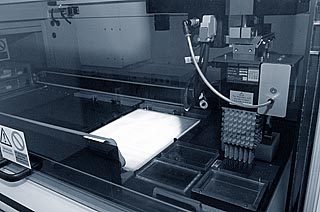 |
An astonishingly large complement of plasmids has been detected in lactococcal
strains isolated from dairy cultures. Their molecular weights range from
2 kilobases (kb) up to over 100 kb. Some plasmids are of the conjugational
or self-transmissible type, i.e., they can transfer themselves from one
strain to another and be stably propagated. Others, although not self-transmissible,
may be mobilized into a new host with the help of self-transmissible plasmids.
Yet another class remains confined to one particular strain.
At first sight, the wealth of naturally occurring plasmids in L. lactis would
seem to offer endless opportunities to the genetic engineer for the development
of cloning vectors. However, many of them have turned out to be cryptic and
none encoded useful selection markers such as antibiotic resistance, which
caused a serious delay in the initial use of endogenous plasmids. In essence,
two approaches have been used to develop vectors useful for cloning in L. lactis:
those like pSH71 that are based on genuine lactococcal replicons engineered
to contain a selectable marker obtained from a ‘foreign’ plasmid (i.e., one originally isolated from a different species), and those like pAMb1 that are based on heterologous replicons already encoding antibiotic resistance markers that turned out to be operational in L. lactis both with respect to stable replication as with respect to functional expression of the selection marker. Several lineages of recombinant plasmids based on either homologous or heterologous replicons have been described. It is not within the scope of this article to give a complete overview of the wide variety of vectors that have been constructed in different laboratories. We merely wish to illustrate the development of specialized vectors designed for the efficient expression of mouse and human cytokines in L. lactis.
Cytokines are a group of proteins, many of which play an important role in
immune regulation, that are being extensively evaluated for use as therapeutics
in a number of diseases. As they are present in minute amounts in the body,
it is not only very difficult to obtain them in pure form in sufficient quantities
but also extremely costly. Therefore, we and others have investigated the possibility
of cloning the genes encoding human cytokines onto lactococcal plasmids with
the aim of producing large amounts of cytokine from L. lactis cultures.
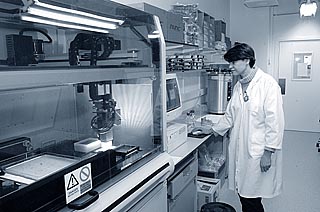 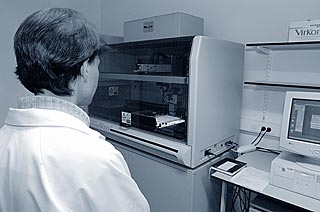 |
pSH71 is a small, cryptic plasmid that was originally isolated from L. lactis.
It has a broad host range for gram-positives and can also replicate in E.
coli. The pLET2N plasmid was developed by the application of several successive
cloning
steps. This plasmid contains resistance genes for the antibiotics kanamycin
and chloramphenicol, which serve as selection markers during transformation.
The plasmid also carries a very strong inducible promoter derived from the
coliphage T7. Downstream of the promoter, a DNA fragment was cloned that
codes for the secretion signal sequence of the lactococcal protein Usp45.
This protein
is naturally secreted in fairly large amounts by L. lactis. Its function
is as yet unknown. The nucleotide sequence of the usp45 secretion signal
was engineered
in such a way that it contains a unique restriction site that allows the
insertion of essentially any coding region of an adventitious gene in frame
with the
secretion signal peptide of Usp45. We constructed derivatives of pLET2N that
contain the coding regions for the mature part of the mouse and human interleukin-2
genes, respectively. The plasmids are maintained in the L. lactis strain
MG1820. This strain contains two additional plasmids: a large endogenous
lactococcal
plasmid that carries the lactose operon including the lac repressor and plasmid
pILPol, a derivative of the heterologous, broad host range replicon pAMb1
onto which the coliphage T7 RNA polymerase gene was cloned under transcriptional
control of the lactococcal lac promoter. This triple plasmid configuration
constitutes an inducible expression system. In the absence of lactose, the
lac promoter and consequently the synthesis of T7 RNA polymerase are repressed.
As the T7 promoter needs the latter for its activity, the entire system remains
silent. Addition of lactose lifts repression by the lac promoter and induces
synthesis of T7 RNA polymerase, which in turn activates the T7 promoter to
obtain high-level transcription of the downstream sequences.
Using this system, we obtained up to 1 mg of secreted human interleukin-2
per litre of L. lactis culture. The protein was correctly processed and displayed
the same specific biological activity as an international human interleukin-2
standard.
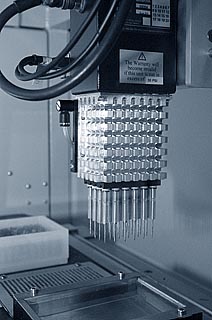 |
pAMb1 is a self-transmissible plasmid originally isolated from Enterococcus
faecalis. It has been shown to replicate in the gram-positive genera, Bacillus,
Clostridium, Staphylococcus, Leuconostoc, Pediococccus, Lactobacillus and Lactococcus.
In L. lactis it displays a high copy number and shows high structural and segregational
stability, even when large, adventitious DNA sequences are inserted. These
properties made it the plasmid of choice for the development of a series of
cloning vectors for L. lactis. In essence, the parental pAMb1 plasmid was trimmed
to its essential replicon and supplied with genes coding for resistance to
antibiotics, such as kanamycin, chloramphenicol or erythromycin. We used a
lineage, designated pT1NX, for the efficient synthesis of murine and human
interleukin-10. Plasmid pT1mIL10 specifies resistance to erythromycin and contains
the strong, constitutive, lactococcal P1 promoter as well as the Usp45 secretion
leader sequence to which the coding region of mature mouse interleukin-10 is
fused. Strain MG1363, a derivative of
L. lactis subspecies cremoris that had been cured of endogenous plasmids, served
as the recipicient for transformation with pT1mIL10. The recombinant strain
produced up to 3 mg mIL10 per litre of culture.
Because interleukin-10 has a central role in down-regulating inflammatory cascades,
it is a likely candidate for use as a therapeutic agent in inflammatory bowel
disease (IBD), including Crohn’s disease and ulcerative colitis. IBD affects around 2 in every 1000 individuals in western countries and its incidence is increasing. The clinical picture is characterized by recurrent severe inflammation of the large and/or small intestine. The symptoms of both are extremely unpleasant and impact all aspects of the quality of life. They include diarrhea, abdominal pain, rectal bleeding, fever, nausea, weight loss, lethargy and loss of appetite. Although many patients are managed successfully with conventional medical therapy, such as anti-inflammatory corticosteroid treatment, some remain refractory to treatment, most will have recurrent disease episodes, and two-thirds will require surgery.
We orally administered live cells of L. lactis strain MG1363 containing pT1mIL10
to mice in which chronic colitis had been chemically induced. The lactococci
delivered IL10 in the colon and reduced the mucosal inflammation by about 50%.
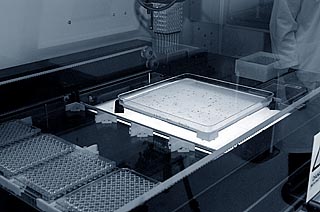 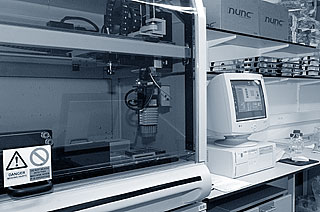 |
In order to evaluate this approach in humans, we also constructed pT1hIL10,
which directs the synthesis and secretion of human interleukin-10 in L. lactis.
However, in view of legitimate concerns about the safety of genetically modified
organisms (GMOs), we had to develop a recombinant L. lactis strain that was
biologically contained. We exchanged an essential gene on the lactococcal chromosome
for the gene encoding human interleukin-10. The strain is free of plasmids
and antibiotic resistance markers and depends for growth on an additive that
is not found in the environment. The strain has been approved by the Dutch
authorities as an experimental therapy and is now being evaluated in a clinical
trial with patients suffering from Crohn’s disease.
Sources and further reading
| Prof. Dr. Erik Remaut Scientific Adviser BCCM/LMBP Department of Molecular Bio- medical Research VIB – Ghent University Technologiepark 927 9052 Zwijnaarde |
New address for the BCCM/LMBP plasmid collection !
|
New address
for the BCCM/LMBP plasmid collection ! 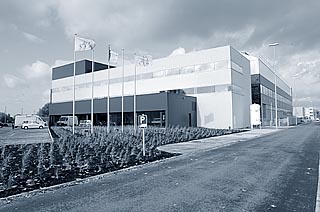 The BCCM/LMBP plasmid collection has moved to new premises of the Ghent University in Zwijnaarde (Belgium). BCCM/LMBP disposes of new, state-of-the-art laboratories and equipment, which will help them to manage efficiently its collection of plasmids and DNA libraries. In future contacts, please use the following coordinates:
|
 The team of the BCCM/LMBP plasmid collection (from left to right): Marcelle Beernaert, Kathleen De Zutter, Anneleen Olbrechts, Gratienne Verheijen, Roland Contreras (director), Martine Vanhoucke (curator) (Erik Remaut, scientific advisor, is missing on the picture). |
Home |
Contents Edition 14 - November, 2003 |
Next Article Edition 14 - November, 2003 |